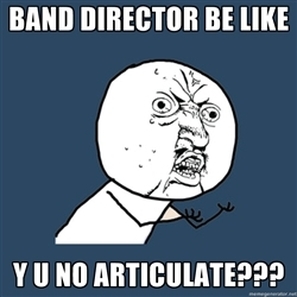 Many band directors are perpetually frustrated with the quality of their students’ articulation. I do not want to downplay its importance; articulation cannot be ignored. Yet I often ponder, are we treating the symptoms or the disease? I believe articulation is similar to the game “Jenga.” Without an adequate foundation the structure crumbles. If the student is lacking prerequisites it is futile to focus on articulation. My next blog post will introduce strategies that are specifically geared towards improving articulation. Here are my thoughts regarding several items that must be addressed first. Posture and Holding Position: Often when diagnosing the cause behind a fundamental deficiency it is discovered that there is a “problem behind the problem.” For low brass musicians this is often traced back to their posture and holding position. If their posture is improper other aspects of performing follow suit. If the lungs cannot fill to their full capacity muscles become tense and other aspects of performing will suffer. Have you ever called tech support only to have someone ask you if your device is plugged in? As infuriating as that may be there is good reason why it is the first question asked. The simplest solution is usually the correct one.  Breath Support: All sounds are vibration. On wind instruments the vibration is created by our air column. Therefore, there is no sound without wind. To focus on articulation before establishing breath support is a waste of time. Prep, Onset, Follow Through: Consider using the term “onset” in place of “attack.” After all initiating a tone requires more of a refined touch. That notwithstanding, to focus solely on the onset is a bit short sided. A golf swing includes a backswing, point of contact, and follow through. To produce a tone we must include a preparatory breath, articulation, and follow though. Is the preparatory breath adequate? Is your ensemble breathing together? Are the students holding in the air prior to the onset? This often results in an explosion of air at the onset and a less than centered tone. Is their air supporting the sound through the body of the note? Through the phrase? Tempo, Rhythm, and Timing: If your ensemble is not in sync its sound can be muddy. This can easily be interpreted as poor articulation but an uneven tempo or rhythmic deficiencies are often the culprit. If their timing isn’t precise it will not sound clean. I have witnessed a phenomena in young low brass students that I refer to as “countis interuptis.” When a student encounters a rhythm which they are uncomfortable with their instinct is to slam on the brakes. This closes off the air stream and results in a less confident sound, therefore compounding the rhythmic errors. If a student is choking off their air supply and has poor timing then they cannot articulate successfully. Therefore it is imperative to incorporate rhythm and music reading skills into your rehearsal. With these prerequisites in place articulation should be addressed. I will discuss strategies in my next blog post. Happy #TubaTuesday!
0 Comments
Your comment will be posted after it is approved.
Leave a Reply. |
Archives
October 2021
Categories |

 RSS Feed
RSS Feed